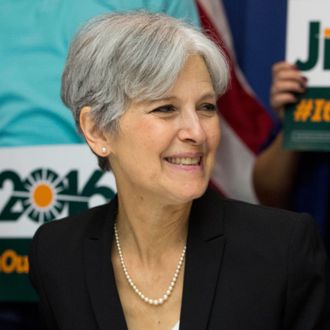
Thanks to the extreme unhappiness of Republican elites and many GOP voters with Donald Trump, most of the third-party speculation this year has been around the possibility of a “movement conservative” independent candidate. As that scenario has slowly faded, the Libertarians went the extra mile to make their ticket attractive to disgruntled GOPers, with two former governors running. Accordingly, Libertarian nominee Gary Johnson is beginning to register in the high single-digits and low-teens in trial heats against Trump and Hillary Clinton, with prospects for doing better if the GOP convention is the fiasco some observers expect. Indeed, Johnson is within shouting distance of the 15 percent poll-showing that would qualify him for general-election presidential debates, which all third-party candidates view as a breakout opportunity.
But there’s a fourth candidate already out there who, like Johnson, enjoys the support of a preexisting party with a clear identity and access to the ballot in many states: Jill Stein, making her second consecutive run for president, as the presumptive Green nominee for 2016 (she will, barring a strange upset, be formally nominated at the Green convention in early August).
Stein and her party have a natural affinity with the less Democratic-minded elements of the Bernie Sanders coalition; her platform includes single-payer health care, a carbon tax, and student-loan-debt forgiveness. A recent CNN/ORC poll showed Stein winning 18 percent of the Democrats and independents who currently favor Sanders if Clinton wins the nomination. The same survey showed Stein at 7 percent overall; with Johnson at 9 percent. If these numbers actually held into the heat of the general-election campaign, 2016 could become the first presidential election with four serious candidates since 1948 when Strom Thurmond’s States’ Rights Party and Henry Wallace’s Progressives all ran credible campaigns.
While the Johnson-Weld Libertarian ticket looks to have some staying power, it’s not so clear Stein’s Greens can say the same. For one thing, she’ll need to expand ballot access well beyond her current list of 21 states to achieve anything like those CNN/ORC numbers. And historically, minor parties have almost always lost steam as actual voting approaches. In the high-watermark Green presidential campaign of all time, Ralph Nader’s famous (or infamous) 2000 run, the former consumer crusader was polling at 6 percent in October before settling in at 2.7 percent.
Speaking of Nader and 2000, the Clinton campaign is sure to use that precedent to argue that a vote for Stein is a vote for Donald Trump, and if the Clinton/Trump race is close, that could have a powerful effect. The bigger problem for Stein is that this particular moment may represent the absolute peak of her appeal to Sanders supporters, many of whom will slowly drift into the Clinton column as the Bern subsides and Sanders himself begins to warn his fans against the Green Temptation.
The Greens could also face some corrosive competition with the Libertarians for voters unhappy with the two-party choice. While many young Sanders supporters could be attracted by Johnson’s support for drug legalization and a noninterventionist foreign policy, there probably aren’t many disgruntled Republicans who could bring themselves to associate with the Greens. Add in Johnson’s early lead, superior ballot access, and the possibility of a seat at the debates, and Stein could become an afterthought.
In the end, Jill Stein will almost certainly beat her 2012 performance of 469,000 votes (0.36 percent of the total). But unless something odd happens, she won’t make anyone forget Ralph Nader — or Henry Wallace.






























